This week’s Weekly includes my review of Peter Gourfain‘s solo exhibit at Projects Gallery and a sketch about Jina Valentine‘s inclusion in the Harlem Studio Museum show “Frequency.” That’s on the art page. In the listings section is my editor’s choice on the current Vox Populi members exhibit by William Lohre and Samantha Simpson. Here are Libby’s posts on Gourfain, Frequency and Vox.
The Humanist Body
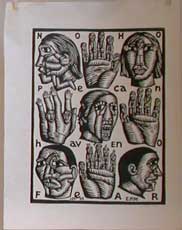
It’s hard to imagine Peter Gourfain was ever a minimalist. But the 71-year-old New York-based artist whose politically charged woodblock and lino-cut prints are on view at Projects Gallery had a spell as an abstract painter early in his career. His minimalist works were so good they landed him in the 1968 Whitney Biennial and in a 1966 show called “Systemic Painting” at the Guggenheim.
In the 1970s Gourfain switched to making narrative paintings, carvings, ceramics and prints, drawing on his years of sketchbook work and his lifetime observing politics with empathy for the poor and outrage over injustice. (image is one of Gourfain’s prints that uses hand-play with hands made of faces and bodies)
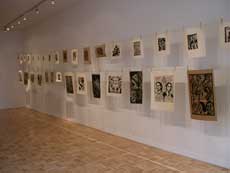
In a catalog for his 2002 retrospective at the Elvehjem Art Museum (now called the Chazen Art Museum**) in Madison, Wis., the Chicago native says he’s always seen art and life as interwoven. So the switch from abstract to reportorial is natural, allowing the artist to chronicle his thoughts about humanity-from people he sees on the subway to victims of police violence he reads about in the newspapers to characters he reads about in books. James Joyce is a favorite of his, and one of the best works in the show is the raucous word-filled print Finnegan’s Wake, a multipanel cartoon based both on the Irish drinking song and on Joyce’s work.
(image above is the clothesline-hung show. Many other works are framed and hung directly on the wall but the prints pinned to the line have a nice urgency to them. Below is Finnegan’s Wake.)
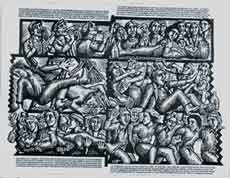
Gourfain’s humanist focus reminds me of Kathe Kollwitz and Elizabeth Catlett. Faces and bodies are depicted monumentally in the broadest terms, using the bold black-and-white aesthetic that’s natural in block-cut prints. Lines are thick and dark, and light areas are the blinding white of the paper. It’s not a land of subtle lines and gray areas in either subject matter or technique.
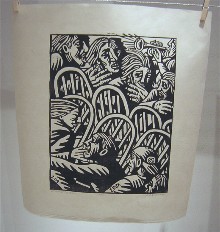
Like many artists with a message, Gourfain uses words and wordplay to spell out his theme. The works are manifesto-like, and the words hit like a punch. “When money speaks, truth is silent,” says one (left). In Noho Pecan, the wide-spaced letters spell out a poignant revolutionary message: “No Hope Can Have No Fear.” Other works depict hands using sign language to convey their messages.
(chairs and ladders are other recurring visual motifs that have both literary and art-references)
Gourfain is a friend of artist Paul Santoleri, whose art is also in the activist humanist tradition. Santoleri’s exhibit “Linear Interference” is at the Painted Bride until Jan. 14, and the shows make exhilarating complementary viewing.
**(By the way, you can see Gourfain’s monumental carved and ceramic piece “Roundabout” at the Chazen until July 16, 2006. It’s been up since last July.)
“Peter Gourfain: What Folly … ”
Through Jan. 29. Projects Gallery, 629 N. Second St. 267.303.9652.
sketches
Valentine’s Day
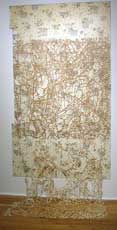
Jina Valentine, an assistant director at Fleisher-Ollman Gallery (where she’s helped organize three hot emerging artists shows including the current “Meatballs”) is herself in a blockbuster New York exhibit. “Frequency” at the Studio Museum in Harlem is billed as a roundup of “35 of the hottest emerging black artists of 2005.”
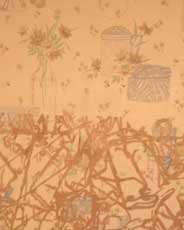
The show is great, and Valentine’s work stands out for its spiritual questing, surprising materials and crafting.
(top image is installation shot of one of Valentine’s two pieces in the show. Next image is a detail.)
The artist works with found materials. She installed a large wood panel covered with yellowed ’50s-era kitchen wallpaper into the gallery wall, inset like a perverse wallflower. Halfway down the panel she carved a complicated lacey but random pattern into the wallpaper skin and pulled the carving off the wall so it drapes curtainlike onto the floor.
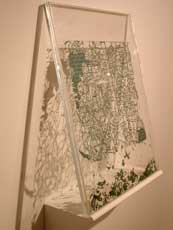
Her Appetite for Destruction: Top 40 Best Selling Albums piece refers to music and remixing. But its references to skin, walls and infrastructure evoke the lives of women and domestic labor that’s taken for granted. A meditation on loss, love and home, the work is a grandchild of Rothko and Eva Hesse.
(last image is Valentine’s smaller work in the show, also called Appetite for Destruction: Top 40 Best Selling Albums. The artist told me in an email that the Studio Museum has just purchased the piece!)
Through March 12. Studio Museum in Harlem, 144 W. 125th St., New York. 212.864.4500.
editors picks
“Bill Lohre: Red and Yellow Alert” and “Samantha Simpson: The Problem of Prevost’s Squirrel”
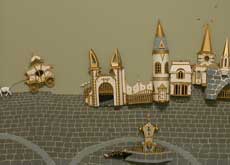
Vox member Bill Lohre‘s art has gone from room-sized installations to wall-based landscapes to the gemlike miniature tableaux in his new show “Red and Yellow Alert.” Lohre’s installations were like exploded Grimm’s fairy tales that reeked of bad human behavior and children lost in the woods. Their scale was threatening. The new beautifully crafted shadow boxes (including several castle scenes (like the one pictured above) and an ocean scene) are fairy tale-precious, minus the threat. Due to their size and framing, the new works suggest televised or picture-book stories—decorative and entertaining. Scaled up for that “you are there” immersion, they’d have awesome power.
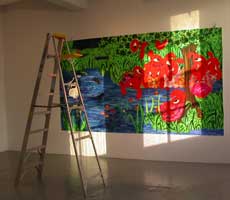
Speaking of immersion, in the front gallery Samantha Simpson‘s large airbrush works on paper, collectively titled “The Problem of Prevost’s Squirrel,” throw you into the world of animals and imperiled families. A caged squirrel is based on an animal at the Philadelphia Zoo. Simpson’s brightly colored and intricately patterned works are delicious, and their huge scale is perfect. (image with ladder gives you an idea of the scale.)
Through Jan. 2. Vox Populi Gallery, 1315 Cherry St., fourth fl. 215.568.5513.









